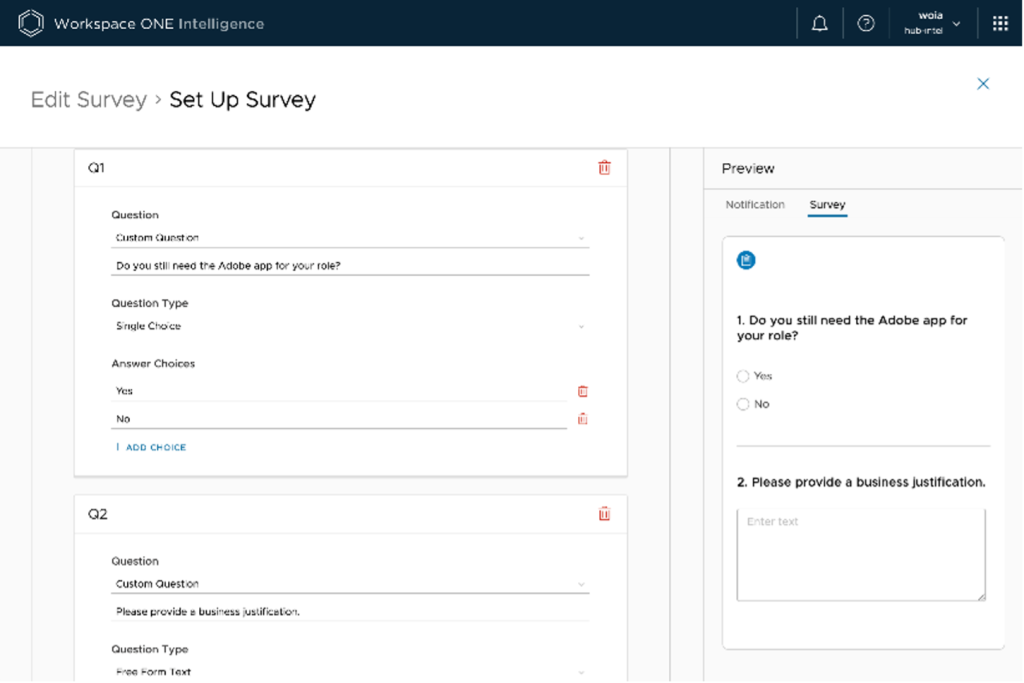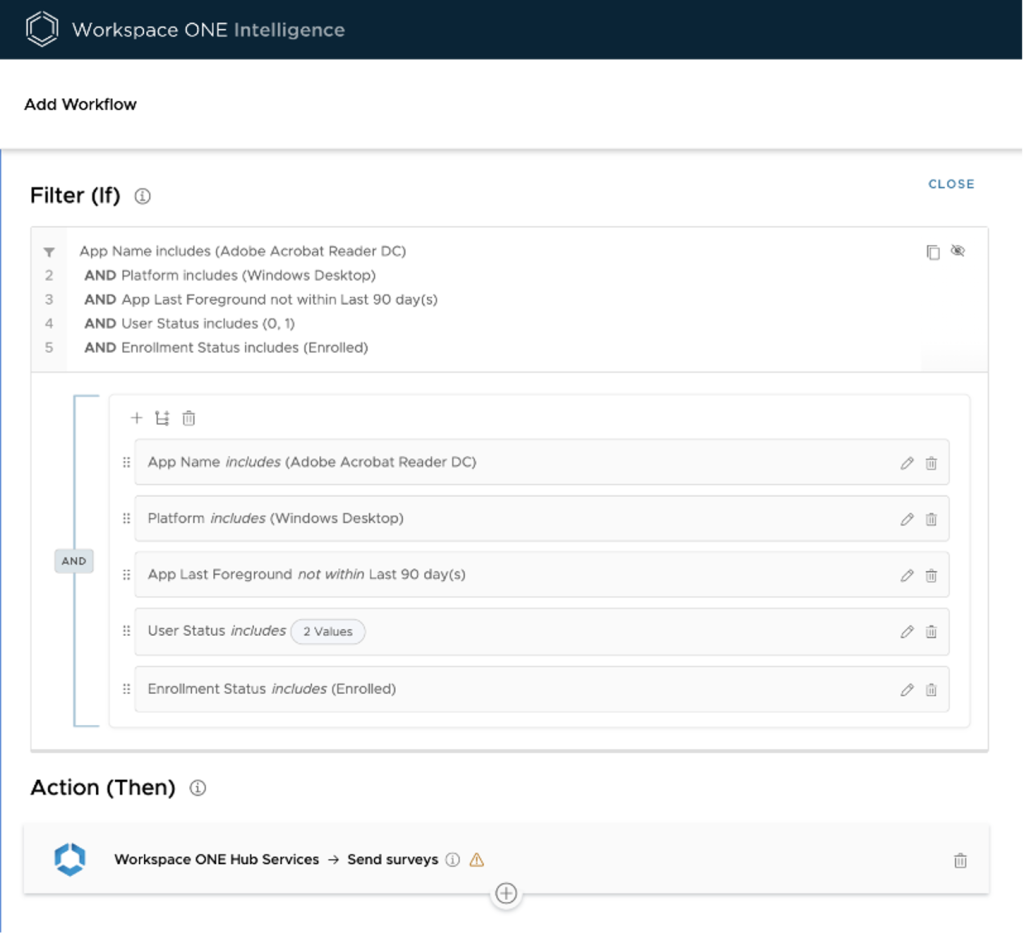Digital employee experience (DEX) is a critical strategic initiative for companies today, helping them overcome challenges like employee attrition, management of growing corporate software resources, and enablement of a hybrid work or a fully remote workforce. To mitigate these issues, it is critical that organizations measure key employee experience metrics to get a pulse on employee sentiment.
Admins can use VMware Workspace ONE Intelligence surveys to push survey notifications to their users in Workspace ONE Intelligent Hub. These questionnaires can collect employees’ feedback about their resources, tools, and experience. This capability provides employers with a survey tool that can help effect change in their organization and strengthen positive sentiments among their teams. They can use this data to make changes to policies, remove or provide licenses for apps, and find solutions to potential end-user issues proactively. To illustrate how this creates value for our customers, we have summarized five of the most impactful survey use cases.
1. App license reclamations
Organizations are rolling out more applications than ever to help empower their employees to be productive. But many companies are reaching a tipping point, where additional applications actually subtract from value. This is because organizations are paying for app licenses, but employees are not using the apps. This can be a costly problem for business leaders if left unattended while the billing cycles pass. While admins may suffer from managing an overload of unused or unneeded resources, some employees may lack access to important applications due to licensing restrictions.
With Workspace ONE Intelligence, stakeholders can publish and push a survey to conduct an audit on users’ app licenses — and ensure licenses are allocated to the employees that need them the most. App license stakeholders can apply Workspace ONE Intelligence surveys in app license audits during quarterly cross-charges or before annual subscription renewals. With Workspace ONE Intelligence, admins can identify licenses with the lowest usage by segmenting license holders based on activity, by checking if an app was installed or if it was used in the last 90 days. If a user responds that they no longer need the app, an admin (or in some cases, an automated workflow) can uninstall that application from the employee’s device and reclaim that app license.


2. Proactive IT support and remediation with detected device or app issues
Providing tech support to remote workers has become one of the biggest challenges for organizations that have adopted a hybrid work model. IT help desks are handling more tickets with fewer workers, and hybrid work has made widely accepted remediation processes less effective. Decision makers need a solution that prevents issues when possible and empowers their employees to access remediation steps quickly and easily.
When an admin detects an issue with devices or apps, they can send a survey from Workspace ONE Intelligence, asking users to confirm whether their experience is being affected and proactively give them steps to fix the problem. Admins can also create workflows to automatically send out a survey when a user has encountered a specific device or app issue. For example, an admin can configure a workflow to send a survey asking the user if they need assistance if it detects that the user’s device is experiencing high OS crash rates. IT admins can reach out to users about these issues instead of waiting for users to report and submit tickets about the problem by sending out this contextual survey.
3. Employee pulse and experience surveys
Increasingly disparate workforces make it difficult for companies to get feedback on their employees’ experiences, but that information is valuable for decision making and experience improvement. It is critical that leaders find new ways to engage with their workers and discover what IT strategies are helping their employees work more productively.
Workspace ONE Intelligence enables leaders to push employee pulse or experience surveys to get feedback about their sentiment regarding company objectives, challenges, and digital employee experiences. The recipients can be targeted by function or department to provide more actionable information. This feedback is valuable for the company to know what they are doing well and what needs to be improved, allowing them to make more impactful changes to their strategies.
4. App consolidation and rationalization
Business units and functional leaders often make purchasing decisions when it concerns applications that are specific to their employees’ needs. While this is a great policy for empowering teams, it can lead to an overload of resources that creates an overlap in functionalities. Organizations can benefit from reducing similar applications and ensuring that each purchase has a unique use case.
Admins can send surveys to collect information about how each application is used by employees and their preferred tool. That data can provide valuable insight to reduce the number of applications being used by the organization, simultaneously cutting overhead costs and reducing resource clutter.
5. App feedback to drive engagement and usage
Companies are increasingly creating internal applications that fit unique use cases within their organization. However, sometimes new tools are slow to gain adoption internally, either due to issues with the app itself or employee awareness of them. Those challenges can only be overcome by digging into employee sentiment and identifying problems and actionable solutions.
With Workspace ONE Intelligence, admins can target users who have the internal app and send surveys asking questions about their experience. What do they like about the app? What do they dislike? What improvements would they recommend? Why are they using or not using the app today? Responses to questions like these can reveal where changes can be made to increase the adoption and effectiveness of an application and to identify potential hurdles for future application releases.
Decision making becomes easier with reliable data, and surveys can help you collect current and relevant information on your employees’ experience. To learn more about how you can leverage surveys in your organization, check out these key resources:







